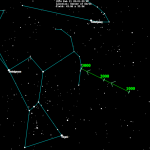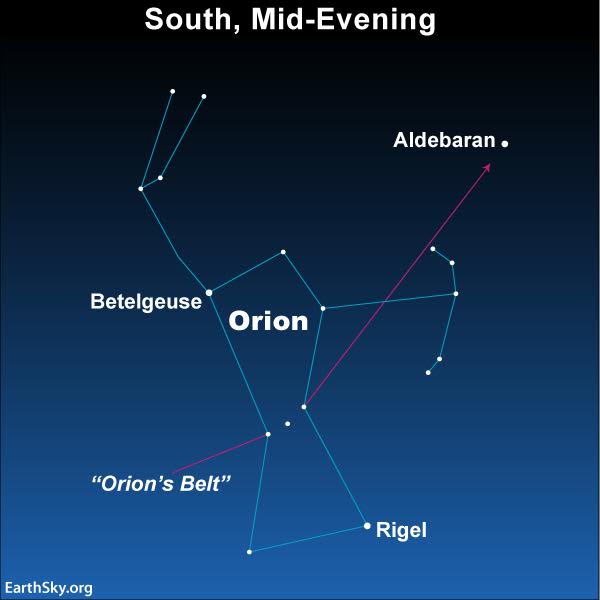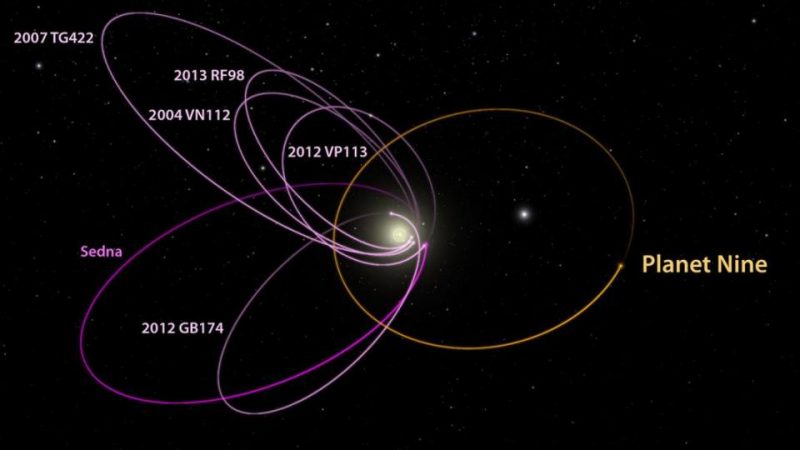
Above image of Planet 9’s path via Wikipedia
Tonight, let the constellation Orion the Hunter show you the approximate position of the hypothetical Planet 9 in the starry sky. As of now, nobody has yet seen this hypothetical solar system planet, which, if it exists, is large and very distant. But – still, hypothetically speaking – there are reasons to believe it does exist, and so for astronomers and citizen scientists … the hunt is on.
Two Caltech astronomers – Mike Brown and Konstantin Batygin – claim to have solid theoretical evidence for a 9th major planet in the outer solar system moving in a bizarre, highly elongated orbit. Recently, however, some astronomers have offered an alternative explanation to their data, saying it doesn’t necessitate the presence of a Planet 9.
Mystery orbits don’t require a Planet 9, researchers say
The astronomer Scott S. Sheppard guesses this planet might shine somewhere between 23rd and 25th magnitude, making this world about 6 to 40 million times fainter than the faintest celestial object visible to the unaided eye. Still, it’s fun to imagine the place in the sky where astronomers are searching for Planet 9.
The sky chart at the top of this post shows that location. The chart, which is via Wikipedia, shows Planet 9‘s possible path across our sky, in front of the backdrop stars, from the years 1000 to 3000 AD.
Although this world, if it exits, is way beyond the range of our backyard telescopes, we can still star-hop from the constellation Orion to Planet 9’s possible location in the starry sky.
From around the world at this time of year, the constellation Orion climbs highest up for the night around mid-evening (9 to 10 p.m.) local time. From temperate latitudes in the Northern Hemisphere, Orion appears in the southern sky at mid-evening. From the equator, Orion appears high overhead, and from temperate regions in the Southern Hemisphere, an “upside-down” Orion shines in the northern sky.
Some of you may know how to star-hop from Orion’s Belt to Aldebaran, the brightest star in the constellation Taurus the Bull. If not, refer to the sky chart below. Once you’ve found Aldebaran, you’ve pretty much found the proposed location of Planet 9, which – again, if it exists, and if astronomers are right about its location in our solar system – lodges pretty much directly east of Orion’s Belt and directly south of the star Aldebaran.

Use Orion’s Belt to star-hop to the star Aldebaran.
Caltech astronomers first announced a hypothetical Planet 9 on January 20, 2016. What they called “solid theoretical evidence” exists for a giant planet – a 9th major planet in the outer solar system – moving in what they called a “bizarre, highly elongated orbit.” They nicknamed it Planet 9 then, and they said hoped other astronomers would search for it.
If it exists, the planet has a mass about 10 times that of Earth and orbits about 20 times farther from the sun on average than Neptune, which is currently the 8th major planet and which orbits the sun at an average distance of 2.8 billion miles (4.5 billion km).
The astronomers say it would take this new planet between 10,000 and 20,000 years to make just one full orbit around the sun.

The orbits of 6 extreme trans-Neptunian objects (in magenta), all mysteriously aligned in one direction. These orbits were used by Caltech astronomers to hypothesize a Planet 9 (in orange). Image via Caltech/ R. Hurt (IPAC).
Read more: Solid evidence for a 9th planet
Bottom line: Astronomers are searching for a hypothetical Planet 9 in the starry sky. You can use the constellation Orion to show you approximately where they’re looking.
from EarthSky http://bit.ly/2WoEkjv

Above image of Planet 9’s path via Wikipedia
Tonight, let the constellation Orion the Hunter show you the approximate position of the hypothetical Planet 9 in the starry sky. As of now, nobody has yet seen this hypothetical solar system planet, which, if it exists, is large and very distant. But – still, hypothetically speaking – there are reasons to believe it does exist, and so for astronomers and citizen scientists … the hunt is on.
Two Caltech astronomers – Mike Brown and Konstantin Batygin – claim to have solid theoretical evidence for a 9th major planet in the outer solar system moving in a bizarre, highly elongated orbit. Recently, however, some astronomers have offered an alternative explanation to their data, saying it doesn’t necessitate the presence of a Planet 9.
Mystery orbits don’t require a Planet 9, researchers say
The astronomer Scott S. Sheppard guesses this planet might shine somewhere between 23rd and 25th magnitude, making this world about 6 to 40 million times fainter than the faintest celestial object visible to the unaided eye. Still, it’s fun to imagine the place in the sky where astronomers are searching for Planet 9.
The sky chart at the top of this post shows that location. The chart, which is via Wikipedia, shows Planet 9‘s possible path across our sky, in front of the backdrop stars, from the years 1000 to 3000 AD.
Although this world, if it exits, is way beyond the range of our backyard telescopes, we can still star-hop from the constellation Orion to Planet 9’s possible location in the starry sky.
From around the world at this time of year, the constellation Orion climbs highest up for the night around mid-evening (9 to 10 p.m.) local time. From temperate latitudes in the Northern Hemisphere, Orion appears in the southern sky at mid-evening. From the equator, Orion appears high overhead, and from temperate regions in the Southern Hemisphere, an “upside-down” Orion shines in the northern sky.
Some of you may know how to star-hop from Orion’s Belt to Aldebaran, the brightest star in the constellation Taurus the Bull. If not, refer to the sky chart below. Once you’ve found Aldebaran, you’ve pretty much found the proposed location of Planet 9, which – again, if it exists, and if astronomers are right about its location in our solar system – lodges pretty much directly east of Orion’s Belt and directly south of the star Aldebaran.

Use Orion’s Belt to star-hop to the star Aldebaran.
Caltech astronomers first announced a hypothetical Planet 9 on January 20, 2016. What they called “solid theoretical evidence” exists for a giant planet – a 9th major planet in the outer solar system – moving in what they called a “bizarre, highly elongated orbit.” They nicknamed it Planet 9 then, and they said hoped other astronomers would search for it.
If it exists, the planet has a mass about 10 times that of Earth and orbits about 20 times farther from the sun on average than Neptune, which is currently the 8th major planet and which orbits the sun at an average distance of 2.8 billion miles (4.5 billion km).
The astronomers say it would take this new planet between 10,000 and 20,000 years to make just one full orbit around the sun.

The orbits of 6 extreme trans-Neptunian objects (in magenta), all mysteriously aligned in one direction. These orbits were used by Caltech astronomers to hypothesize a Planet 9 (in orange). Image via Caltech/ R. Hurt (IPAC).
Read more: Solid evidence for a 9th planet
Bottom line: Astronomers are searching for a hypothetical Planet 9 in the starry sky. You can use the constellation Orion to show you approximately where they’re looking.
from EarthSky http://bit.ly/2WoEkjv

Aucun commentaire:
Enregistrer un commentaire